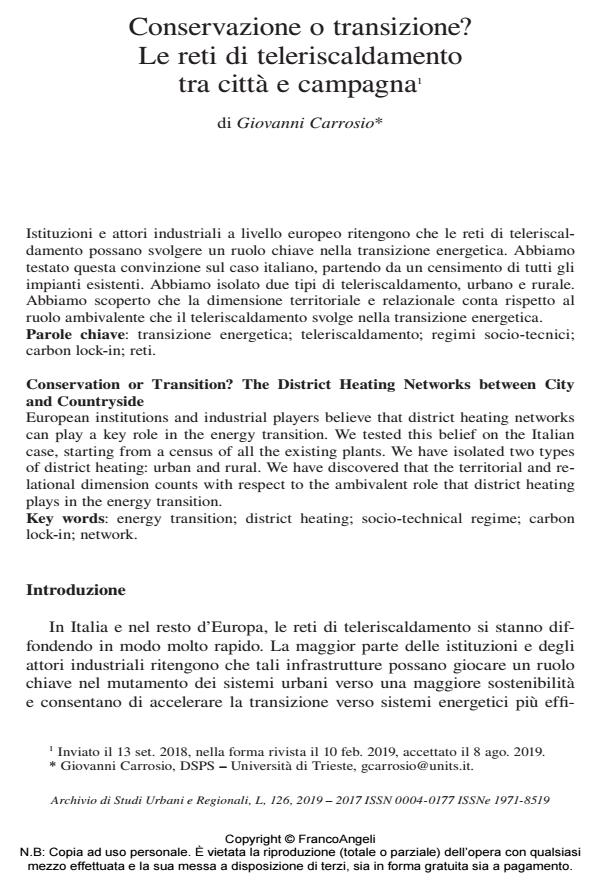Conservation or Transition? The District Heating Networks between City and Countryside
Journal title ARCHIVIO DI STUDI URBANI E REGIONALI
Author/s Giovanni Carrosio
Publishing Year 2019 Issue 2019/126 Language Italian
Pages 21 P. 32-52 File size 375 KB
DOI 10.3280/ASUR2019-126003
DOI is like a bar code for intellectual property: to have more infomation
click here
Below, you can see the article first page
If you want to buy this article in PDF format, you can do it, following the instructions to buy download credits

FrancoAngeli is member of Publishers International Linking Association, Inc (PILA), a not-for-profit association which run the CrossRef service enabling links to and from online scholarly content.
European institutions and industrial players believe that district heating networks can play a key role in the energy transition. We tested this belief on the Italian case, starting from a census of all the existing plants. We have isolated two types of district heating: urban and rural. We have discovered that the territorial and relational dimension counts with respect to the ambivalent role that district heating plays in the energy transition.
Keywords: Energy transition; district heating; socio-technical regime; carbon lock-in; network.
- ARIU (2017). Il riscaldamento urbano. Annuario 2017. Milano: Editrice Alkes.
- Arthur W.B. (1989). Competing technologies, increasing returns and lock-in by historical events. Economic Journal, 99: 116-131.
- Beck U. (2016), Disuguaglianza senza confini. Roma-Bari: Laterza.
- Carrosio G. (2010). Biomasse: Dobbiaco e Campo Ligure. In: Osti G., a cura di, La co-fornitura di energia in Italia. Casi di studio e indicazioni di policy. Trieste: EUT.
- Carrosio G. (2015). Politiche e campi organizzativi della riqualificazione energetica degli edifici. Sociologia Urbana e Rurale, 106: 21-44. DOI: 10.3280/SUR2015-10600
- Chiesi A.M. (2019). L’analisi dei reticoli. Milano: FrancoAngeli.
- Coenen L., Benneworth P.S. and Truffer B. (2012). Toward a spatial perspective on sustainability transitions. Research policy, 41(6): 968-979.
- Cowan R. (1990). Nuclear power reactors: a study in technological lock-in. The Journal of Economic History, 50(3): 541-567. DOI: 10.1017/S002205070003715
- Connolly D., Lund H., Mathiesen B.W., Werner B., Möller B., Persson U., Boermans T., Trier D., Østergaard P.A. and Nielsen S. (2014). Heat Roadmap Europe: Combining district heating with heat savings to decarbonise the EU energy system. Energy Policy, 65: 475-489.
- Dzebo A. and Nykvist B. (2017) A new regime and then what? Cracks and tensions in the socio-technical regime of the Swedish heat energy system. Energy Research & Social Science, 29: 113-122.
- Fritsch M. and Kauffeld-Monz M. (2010). The impact of network structure on knowledge transfer: an application of social network analysis in the context of regional innovation networks. The Annals of Regional Science, 44: 21-38.
- Geels F.W. (2002). Technological transitions as evolutionary reconfiguration processes: a multi-level perspective and a case-study. Research Policy, 31: 1257-1274. DOI: 10.1016/S0048-7333(02)00062-
- Geels F.W. (2014) Regime resistance against low-carbon transitions: introducing politics and power into the multi-level perspective. Theory Culture & Society, 31(5): 21-40. DOI: 10.1177/026327641453162
- Geels F.W. and Schot J. (2007). Typology of socio-technical transition pathways. Research Policy, 36: 399-417.
- Hughes T.P. (1983). Networks of Power: Electrification in Western Society, 1880 e 1930. Baltimore: Johns Hopkins University Press.
- Islas J. (1997). Getting round the lock-in in electricity generating systems: the example of the gas turbine. Research Policy, 26: 49-66. DOI: 10.1016/S0048-7333(96)00912-
- Leurent M., Da Costa P., Rämä M., Persson U., Jasserand F. (2018). Cost-benefit analysis of district heating systems using heat from nuclear plants in seven European countries. Energy, 149: 454-472.
- Lake L., Rezaie B. and Beyerlein S. (2017). Review of district heating and cooling systems for a sustainable future. Renewable and Sustainable Energy Reviews, 67: 417-425.
- Liebowitz S. and Margolis S.E. (1995). Path dependence, lock-in and history. Journal of Law, Economics and Organization, 11(1): 205-226.
- Longo F. (2005). Governance dei network di pubblico interesse. Logiche e strumenti operativi aziendali. Milano: Egea.
- Lund H. (2005). Large-scale integration of wind power into different energy systems. Energy, 30(13): 2402-2412.
- Magnani N. (2018). Transizione energetica e società. Milano: FrancoAngeli.
- Meadowcroft J. (2011). Engaging with the politics of sustainability transitions. Environmental Innovation and Societal Transitions, 1(1): 70-75.
- Osti G. (2008). Relazioni fra consumatori e produttori nel campo delle fonti energetiche rinnovabili. Sociologia urbana e rurale, 85: 41-56. Osti G. (2015), Energia e urbanizzazione: un gioco nuovo e incerto. Sociologia Urbana e Rurale, 106: 7-20. DOI: 10.3280/SUR2015-10600
- Pestoff V. and Brandsen T., (2006). Co-production. The Third Sector and the Delivery of Public Services. NY: Routledge. DOI: 10.1080/1471903060102287
- Späth P. and Rohracher H., (2015). Conflicting strategies towards sustainable heating at an urban junction of heat infrastructure and building standards. Energy Policy, 78: 273-280.
- Smith A., Stirling A. and Berkhout F. (2005). The governance of sustainable socio-technical transitions. Research Policy, 34: 1491-1510.
- Upham P. and Jones C. (2012). Don’t lock me in: Public opinion on the prospective use of waste process heat for district heating. Applied Energy, 89(1): 21-29. --
- Unruh G.C. (2000). Understanding carbon lock-in. Energy Policy, 28(12): 817-830. DOI: 10.1016/S0301-4215(00)00070-
- Valente T.W. (2005). Network models and methods for studying the diffusion of innovations. In: Carrington P., Scott J. and Wasserman S., Models and Methods in Social Network Analysis. Cambridge: University Press. DOI: 10.1017/CBO9780511811395.00
Giovanni Carrosio, Conservazione o transizione? Le reti di teleriscaldamento tra città e campagna in "ARCHIVIO DI STUDI URBANI E REGIONALI" 126/2019, pp 32-52, DOI: 10.3280/ASUR2019-126003